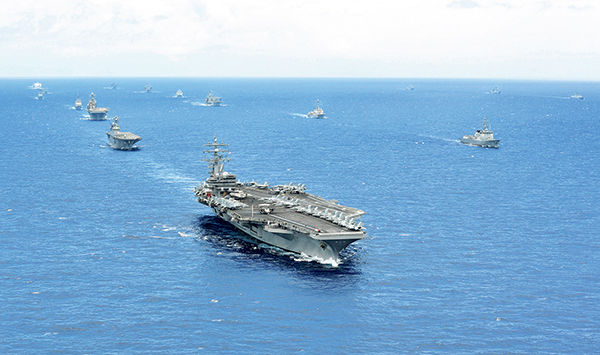LIHUE — The Navy has underestimated the threat maritime exercises and the use sonar poses on marine life around Hawaii and California, a federal judge ruled Tuesday. U.S. District Judge Susan Oki Mollway in Hawaii concluded that the National Marine
LIHUE — The Navy has underestimated the threat maritime exercises and the use sonar poses on marine life around Hawaii and California, a federal judge ruled Tuesday.
U.S. District Judge Susan Oki Mollway in Hawaii concluded that the National Marine Fisheries Service violated environmental laws when it decided that the Navy’s training would have a “negligible impact” on whales, turtles, dolphins and other mammals.
The 66-page ruling said the Navy didn’t explore all possible safeguards to better protect mammals in the ocean, especially given the vast mileage of water that the military used to train.
“The court is saying that the Navy’s categorical and sweeping statements, which allow for no compromise at all as to space, time, species, or condition, do not constitute the ‘hard look’ required by NEPA,” Mollway wrote regarding the Navy’s stance that restrictions would hinder military practices. “The Navy never explains why, if it can accommodate restrictions for humpback whales, it cannot accommodate restrictions for any other species.”
The ruling was praised by environmentalists.
“We’re not trying to stop all training and testing,” said David Henkin, the Earthjustice attorney representing several groups that filed the lawsuit. “But at the same time, it’s important to take the necessary steps to protect all marine life.”
Earthjustice is representing Conservation Council for Hawaii, the Animal Welfare Institute, Center for Biological Diversity and Ocean Mammal Institute challenging NMFS’s approval of a 5-year plan by the U.S. Navy for testing and training activities off Hawaii and Southern California. The groups have maintained that mammals are being unnecessarily harmed, in part, because the Navy doesn’t avoid “biologically sensitive areas.”
The National Environmental Policy Act requires federal agencies to consider a range of alternatives, including ones that could be pursued with less environmental harm, when embarking on operations.
Henkin said the Navy has access to 3.5 million square miles of the waters sweeping from California to Hawaii. Some select areas are particularly sensitive for sea life, such as whales. For example, around 50,000 square miles off Hawaiian waters could be classified as sensitive grounds for marine life, and that size can be avoided while leaving plenty of sea for military operations.
“The court’s ruling recognizes that, to defend our country, the Navy doesn’t need to train in every square inch of a swath of ocean larger than all 50 United States combined,” Henkin said.
“If we can limit or prevent training in these small areas we can limit or prevent these deaths that occur,” he added. “It’s completely avoidable … It’s not what you do, it’s how you do it.”
The Navy said it would evaluate the ruling before determining its next move and couldn’t comment on specifics.
“If the Navy cannot realistically train at sea, sailor’s lives and our national security will be at risk,” U.S. Pacific Fleet spokesman Lt. Cmdr. Nick Sherrouse wrote in response to the ruling. “It is essential sailors have realistic training that fully prepares them to fight tonight, if necessary, and have equipment that has been thoroughly tested before they go into harm’s way,”
What happens next is still to be determined. Exercises could be moved or stricter permitting regulations could be agreed to.
In the meantime, Henkin said he will seek a court order to ensure adequate protections are put in place while it settles out.
“We would invite the government to come to an agreement without a need for more (litigation),” he said. “One way or the other, we are going to do whatever we can to make sure there is adequate protection.”
Held every two years and hosted by the U.S. Pacific Fleet, Rim of the Pacific, or RIMPAC, is the world’s largest international maritime war exercise. In total, 22 nations, 49 surface ships, six submarines, more than 200 aircraft and 25,000 personnel participated in last year’s event from June 26 to Aug. 1. It included live fire target practice, explosives, sonar and the sinking of the decommissioned USS Tuscaloosa 57 nautical miles northwest of Kauai.
The Navy says training will kill 155 whales over five years, but environmentalists say the numbers would be much higher. Some Kauai residents expressed concern when the training was here.
One of those citizens is Hanalei resident and marine biologist Terry Lilley. He copied U.S. Congresswoman Tulsi Gabbard on dozens of emails and photos over the last year documenting what he says shows the serious damage being caused to Kauai’s nearshore marine environment, including green sea turtles, sharks, reefs and coral, by the Navy’s activities.
Gabbard, in turn, wrote a letter in October to Adm. Harry Harris Jr. of the United States Pacific Fleet inquiring about monitoring the effects of military operations on marine life.
“I am very pleased to see that the federal court looked at all of the data about the destruction of our reefs caused by the U.S. Navy war games and made the decision they did,” he wrote in an email to The Garden Island. “We now need to get the destructive activities stopped so we can start working on a massive study and coral reef restoration project.”
Sherrouse said the Navy has been training in the Hawaii and Southern California ranges for more than 60 years.
“This training and testing remains critical to the defense of the nation,” he said. “We are committed to meeting our national security mission and protecting marine life by using protective measures, working with regulatory agencies, and better understanding marine mammals through research.”
But the judge’s ruling stated the Navy doesn’t need all of the waters to still conduct its missions successfully.
She also noted the “stunning number of marine mammals” the Navy’s activities threaten with harm. The judge also found the Fisheries Service violated its legal duties to ensure Navy training would not push endangered whales and turtles to extinction.
“No restriction of any kind is even hypothesized,” Mollway wrote of the Navy’s stance. “Again, the breathtaking assertions allow for no limitation at all, but this makes no sense given the size of the ocean area involved.”
Tom Hasslinger, managing editor, can be reached at 245-0427 or thasslinger@thegardenisland.com.




